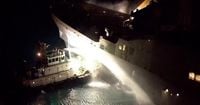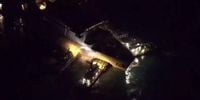In the early evening hours of August 20, 2025, a fierce fire erupted aboard the USS New Orleans, a San Antonio-class amphibious transport dock, while it was anchored off the coast of Okinawa, Japan. The blaze, which began at approximately 4 p.m. local time, would rage for more than 12 hours, challenging the combined efforts of American and Japanese responders before it was finally subdued in the predawn hours of the following day.
The USS New Orleans, a vessel stretching 684 feet and weighing in at 24,000 tons, was stationed at anchor near the White Beach Naval Facility—a vital logistics and support hub for the U.S. Seventh Fleet in the Pacific—when disaster struck. With a crew of over 360 sailors and the capacity to carry up to 800 troops, the ship quickly became the center of an intense firefighting operation that would draw in multiple agencies from both sides of the Pacific.
According to the U.S. Navy’s 7th Fleet, the fire’s initial outbreak prompted an immediate response from the crew, but as the flames spread, it became clear that additional support would be necessary. The Japanese military and coast guard joined forces with U.S. Navy commands, working through the night to contain and extinguish the blaze. As reported by NBC News, videos captured by Japanese broadcaster NHK showed ships spraying water onto the burning vessel, with the focus of their efforts directed at a section of the ship primarily used for stores and berthing.
By around 4 a.m. local time on Thursday, August 21, the fire was largely brought under control. However, the Japan Coast Guard indicated that firefighting efforts continued until after 9 a.m. to ensure the flames were fully extinguished and to allow for a thorough investigation of the affected areas. The coordinated response, which spanned more than half a day, ultimately prevented what could have been a far more catastrophic outcome.
Despite the severity of the incident, only two sailors sustained minor injuries and were treated at the ship’s onboard medical facility. The Navy has not released further details regarding the extent of the damage, but images from local media outlets showed firefighters concentrating their resources on the storage and berthing areas, suggesting that these sections bore the brunt of the destruction.
"The crew will remain aboard the ship while an investigation is conducted to determine the cause of the fire," the Navy stated, as quoted by Fox News Channel. The cause remains unknown, and officials have launched a formal inquiry to establish how the blaze began and spread so rapidly through the vessel’s interior.
The USS New Orleans, commissioned in 2007, is no stranger to the demands of service in the Pacific. Designed to transport Marines, equipment, and supplies, the ship plays a crucial role in U.S. military operations throughout the region. The White Beach Naval Facility, where the ship was anchored at the time, is a strategic outpost that supports the Seventh Fleet’s ongoing commitments in Asia and beyond.
For many observers, the incident brought back memories of the devastating fire that engulfed the USS Bonhomme Richard in San Diego in July 2020. That blaze raged for five days, causing extensive structural, electrical, and mechanical damage, and ultimately led to the ship being scrapped. A sailor was charged—and later acquitted—of starting the fire, but a Navy report concluded that there were sweeping failures among commanders, crew members, and others involved in the response. The shadow of that disaster loomed large as news of the USS New Orleans fire broke, prompting renewed scrutiny of safety protocols and emergency procedures aboard U.S. Navy vessels.
According to BBC, the USS New Orleans incident highlights the persistent risks faced by large naval ships, particularly those stationed far from home ports. The combination of complex machinery, flammable materials, and densely packed living quarters creates an environment where even a small spark can escalate rapidly if not contained. The Navy’s rapid mobilization, along with assistance from Japanese forces, was crucial in averting a more serious tragedy this time around.
Japanese authorities played a significant role in the firefighting efforts. The Japan Coast Guard’s statement emphasized that their crews remained engaged well after the initial extinguishing of the flames, ensuring that every hotspot was addressed and that the ship posed no further threat to personnel or the surrounding environment. This level of cooperation underscores the close military partnership between the United States and Japan, particularly in the face of emergencies that threaten both lives and strategic assets.
As the investigation gets underway, questions remain about the full extent of the damage and the timeline for repairs. The Navy has not yet disclosed whether the USS New Orleans will require extensive dockyard work or if it can remain operational in the near term. For now, the crew will continue to live and work aboard the ship, maintaining security and conducting assessments under the watchful eye of investigators.
The fire’s impact on operational readiness is still being evaluated. The USS New Orleans is one of several San Antonio-class ships tasked with supporting amphibious operations, humanitarian missions, and disaster relief across the Pacific. Any extended downtime could place additional strain on the fleet’s ability to respond to regional contingencies, especially at a time of heightened geopolitical tensions in East Asia.
Local media coverage, including footage aired by NHK, has brought home the dramatic nature of the response and the professionalism displayed by both American and Japanese crews. The sight of water cannons dousing the smoldering ship in the pre-dawn darkness served as a stark reminder of the dangers inherent in naval service—and the importance of robust training and preparation.
For the families of those aboard the USS New Orleans, news that only minor injuries were reported brought a measure of relief. Still, the incident is a sobering reminder of the risks faced daily by service members stationed far from home. The Navy’s ongoing investigation will seek to answer not only how the fire started but also whether any lessons can be drawn to prevent similar incidents in the future.
As the USS New Orleans remains anchored off Okinawa, the story of this fire is still unfolding. With the ship’s crew safe and the flames now extinguished, attention turns to the investigation and the broader implications for naval safety and readiness in the Pacific. The coming weeks will likely bring new details, but for now, the swift response and limited injuries stand as a testament to the resilience and teamwork of those who serve at sea.

